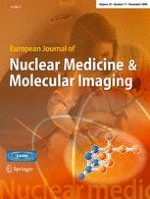Published in:

01-11-2008 | Original Article
Measurement of the internal dose to families of outpatients treated with 131I for hyperthyroidism
Authors:
S. F. Barrington, P. Anderson, A. G. Kettle, R. Gadd, W. H. Thomson, S. Batchelor, P. J. Mountford, L. K. Harding, M. J. O’Doherty
Published in:
European Journal of Nuclear Medicine and Molecular Imaging
|
Issue 11/2008
Login to get access
Abstract
Objective
The aim of this study was to measure the internal dose received by family members from ingestion of radioactive contamination after outpatient therapy.
Materials and methods
Advice was given to minimise transfer of radioiodine. Home visits were made approximately 2, 7 and 21 days after treatment to measure radioactivity in the thyroids of family members. A decay correction was applied to radioactivity detected assuming ingestion had occurred at the earlier contact time, either the day of treatment or the previous home visit. An effective half-life of 6 or 7 days was used depending on age. Thyroid activity was summed if activity was found at more than one visit in excess of the amount attributable to radioactive decay. Effective dose (ED) was calculated using ICRP72.
Results and discussion
Fifty-three adults and 92 children, median age 12 (range 4–17) years participated. Median administered activity was 576 (range 329–690) MBq 131I. Thyroid activity ranged from 0 to 5.4 kBq in the adults with activity detected in 17. Maximum adult ED was 0.4 mSv. Thyroid activity ranged from 0 to 11.8 kBq in the children with activity detected in 26. The two highest values of 5.0 and 11.8 kBq occurred in children aged 5 and 14 years from different families. Eighty-five children had no activity or <1 kBq detected. ED was <0.2 mSv in 86 out of 92 children (93%). Previous published data showed 93% of children received an ED ≤0.8 mSv from external irradiation.
Conclusion
With advice, families of outpatients receiving radioiodine should be able to comply with statutory dose limits and constraints.